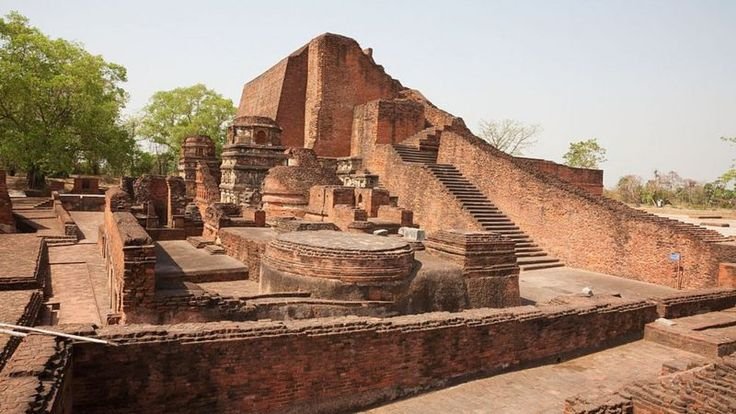Nalanda Mahavihara – The knowledge capital of India

A Buddhist mahavihara, i.e., a great monastery located in ancient Magadha, present-day Bihar, was widely considered to be among the most efficient learning centres of the ancient world. It is often considered to be the world’s first residential university. The university was known to have operated for over a thousand years ranging from 427 CE until around 1400 CE. Nalanda’s contributions in art and academia for the nation helped in shaping the “Golden Age of India.” However, at the end of the 12th century, an invader known as Bakhityar Khilji demolished the monastery and this led to its decline.

Nalanda University was one of the stars of ancient India and stands as a beacon for the glories of scholarly and cultural heritage of the entire country. The university was established during the Gupta Empire in the 5th century CE. Nalanda developed into a premier center of learning for about 800 years. The university is believed to be established under the patronage of Kumaragupta I (reigned c. 415–455 CE), a king of the Gupta dynasty known fondly for intellectual and cultural growth. The university wasn’t, however, an institution of education only, but held within it a fiber of wholeness towards a national commitment to the quest for knowledge and enlightenment. “Nalanda” means “giver of knowledge” from Sanskrit, which captures aptly the spirit and purpose of this institution.
It is believed that the establishment of Nalanda coincides with the golden days of the Gupta Empire – the so-called ‘Golden Age’ in Indian civilization – when art, literature, science, and philosophy experienced a great deal of development and Nalanda became the center of these intellectual activities. The university was situated in the present-day state of Bihar, closer to Rajgir, a historically always significant town, closely associated with that of the Buddha and other spiritual traditions. The selection was also a wise one, embracing trade routes, urban centers, and areas of spiritual importance where Nalanda scholars could invite for their studies students from every place of the subcontinent, as well as many from outside, which gives rise to melting pots of cultures and ideas.

The physical lay-out of Nalanda was as great as its intellectual pursuits. Archaeological excavations indicate large campus areas of sophisticated design, consisting of lecture halls, dormitories, temples, and monasteries. Architectural planning was, however, accurate in terms of functionality and aesthetic aspect. The university boasted a vast library known as Dharmaganja, divided into three buildings- Ratna Sagara (Ocean of Jewels), Ratna Dadhya (Sea of Jewels), and Ratna Ranjika (Delight of Jewels). Countless manuscripts and texts were kept within it on every conceivable subject of Buddhist scriptures to those on astronomy, medicine, and philosophy. It was perhaps the largest repository of knowledge at that time attracting scholars as far as China, Korea, Japan, and Central Asia. Education in Nalanda was rigorous and holistic, as it was available in a spectrum of subjects. It is famous for Buddhist studies but also covers logic, grammar, mathematics, astronomy, medicine, and arts. The university followed a residential model, all students and teachers were housed on campus, thereby lasting learning interchange.

The admission into Nalanda was very selective; oral examination interviews conducted by the faculty determined the student eligibility thereby admitting only very committed and capable students. Thus, the university was regarded as a centre for scholarly pursuit. The extension of the influence of Nalanda was not restricted to the Indian subcontinent; one can say that Nalanda truly overstepped the barriers of becoming even a transnational institution in education. The accounts of Chinese pilgrims and scholars, Xuanzang (Hsüan-tsang) and Yijing (I-ching), who visited Nalanda, make invaluable contributions to understanding how this noble institution worked, and what legacy it left behind. Xuanzang studied and lectured at this eminent university in seventh-century India and gave as detailed an account as possible of the courses, buildings, and learned activities therein.
Innumerable were the manifestations of Nalanda, whose manifestations were so diverse and inclusiveness right where intellectual debates flourished and sharing of knowledge was without barriers to nationalities or religions. It maintained a connection with other important centers of learning and contributed to the global exchange of ideas and innovations. No doubt that royal patronage defined the phase of growth and sustenance for Nalanda. All the later dynasties like the Parthian or Gupta kings, Harsha (7th century CE), and the Pala kings (8th-12th centuries CE) extended patronage to this great university so the budget decided by the royal treasury ensured the prosperity of the university. Additionally, the rulers funded construction and maintenance of the campus encouraging the participation of a wider audience of scholars and students. The Pala dynasty in particular spent considerable effort promoting Buddhist education and constructed Nalanda’s influence over subsequent years.

The decline of Nalanda, however, was as fast and dramatic as its rise. By the 12th century, the fortis had faced very considerable odds against problems of political instability, a decline of the Buddhist influence in India, and the rise of competing centres of learning. The final stroke came in 1193 CE when Bakhtiyar Khalji, the general of the Ghurid Empire, invaded and looted Nalanda. The destruction was horrible: the magnificent libraries of the university flamed to destruction, and multitudes of manuscripts were lost to the irrecoverable muse of India’s intellectual heritage. Thus, this marked the end of one tale; Nalanda became an empty plot gradually being buried under years of neglect. The legacy of Nalanda, however, lives on through all its tragedies in death. The very foundation it had laid education, philosophy, and the cultural exchange with outside shores- has left indelible marks on this earth. It is accepted as one of the very first issues institutions of higher learning have shown in being academic, universal, and inclusive as well as collaborative, but it proved to be a precursor for such institutions. The rediscovery of the ruins of Nalanda in the late nineteenth and throughout the twentieth century drew public attention once more to its history and initiated archaeological excavations, efforts to conserve what was left, and finally, in 2016, the preparing of Nalanda Mahavihara’s site for inscription on the list of UNESCO World Heritage Sites.

By the beginning of the 21st century, these historical efforts toward reviving Nalanda had taken form in India’s commitment to its ancient heritage, asserting India’s role in and concern toward global education. Contemporary Nalanda University was created in 2010 adjacent to the original site and aspires to revitalize the spirit of that institution, leaving many lessons in handling the modern challenges of education, for example, interdisciplinary learning and internationalization, along with sustainability, all by the legacy of its inspiration, that of the original Nalanda. The history of this institution is the story of humanity’s desire and achievement. Herein lies the glory and sadness of a civilization that placed humanity’s highest hopes and endeavors on knowledge and its dissemination. It stands as a modern beacon of ancient wisdom, continuing to inspire generations about transformed minds and its quest for enlightenment. It is a story that attests not only to India’s history but to the universal human endeavor of seeking and sharing knowledge.


